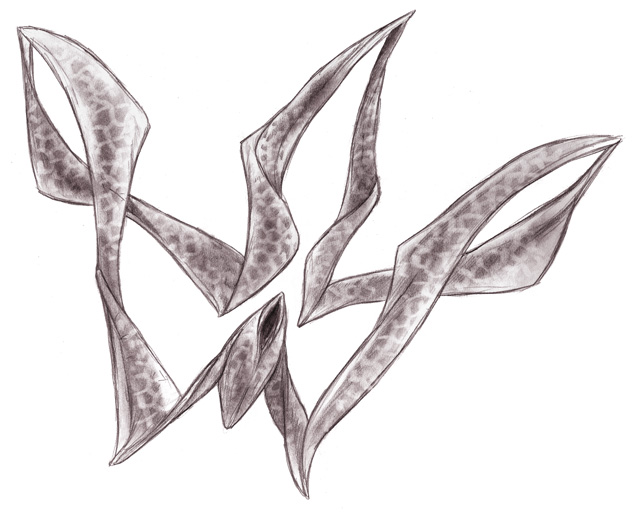The alien has received some attention recently from Sigmund Nastrazzurro's latest blog post. The main body of the post doesn't seem to focus on the movement of the Moebius Fish (detailing a bauplan that more closely resembles the Sugerea of Nereus), but there seems to be some speculation in both the post and the attached comments on exactly how thomastapir's creation could work. Far too complex to submit in the comments section, this blog post is my offering to that discussion.
I've worked off and on with an animation that would help satisfy my curiosity of how the Moebius Fish would move, and the recent attention has inspired me to make something presentable of what I've been able to accomplish.
Stage 1: Torsion
In the description, thomastapir says that the Moebius Fish is "a marine organism that "swims," and feeds, by turning itself inside out--or more accurately, reversing the orientation of its body surfaces." To my mind, this would look something like this:
Notice that this isn't a constant, universal rotation, but rather a sort of 'phased torsion' of each segment along the length of the ribbon. Even though this is only one aspect of the creature's motion, already it has hypnotic qualities as suggested in the description. This takes into account other points of the creature's description as well, namely the fact that the "node" doesn't rotate along with the rest of the body, and that the ribbon repeatedly inverts itself. Mind you, what I'm showing here is a simplified illustration of the principle. This animation only shows 180 degrees of rotation, and the Moebius Fish would likely be able to twist even further. That much at least seems evident from thomastapir's artwork.
Stage 2: Movement Pattern
After exploring the "inside out" aspect of the Moebius Fish, I next needed to animate its movement cycle. It's important to point out that I made no attempt to precisely match the creature's drawing, but rather to illustrate the basic principles of how such a creature might move. I have done nothing to calculate hydrodynamic forces nor efficiency of movement, so what I have here is a rough approximation of a simplified Moebius Fish swimming stroke:
This image reflects several details from the description, specifically where thomastapir says, "It would then smoothly pull in all its body segments to reduce drag and invert them forward/back again to its initial starting posture." Already you can see how much more simplistic this animation is, only showing one significant "curl" in its sequence, whereas the drawing shows three or four. Had I sufficient time and resources, I could create something that would be much closer to how a Moebius Fish would swim, but for now I think this does the trick.
Stage 3: Putting It Together
When I take these two aspects of the Moebius Fish and put them together, I get this:
While I think it's a good first effort, there are several things that I think deviate from what I imagine:
- If you look at the segments of the ribbon closest to the node you may notice, as I did, the 'flapping' motion. I don't know if an actual Moebius Fish would find this advantageous, but it was an inadvertent artifact of my haphazard assembly of this animation.
- On that note, the leading edge of the ribbon's swimming stroke is rather pointy. This is true to the description in regards to returning to the forward-most position, and likely a hydrodynamically sound idea, but on the backstroke, when pulling water back, I don't know if it's best to maintain that point as this animation shows.
- This animation is also fraught with what is known in the relevant jargon as 'collisions': points where the different surfaces intersect. No creature existing within the physical realm would be capable of such a feat, and so any future work I do with this would have to account for the width and flexibility of the ribbon in order to avoid such problems.
- There are no doubt other flaws in this animation, but they weren't so problematic as to distract from the concept and warrant further attention. Again, this is intended to be a rough animation of how a Moebius Fish could move; if I had millions of years to perfect the swimming stroke, as this species would hypothetically have, then the overall motion would indeed be much prettier.





